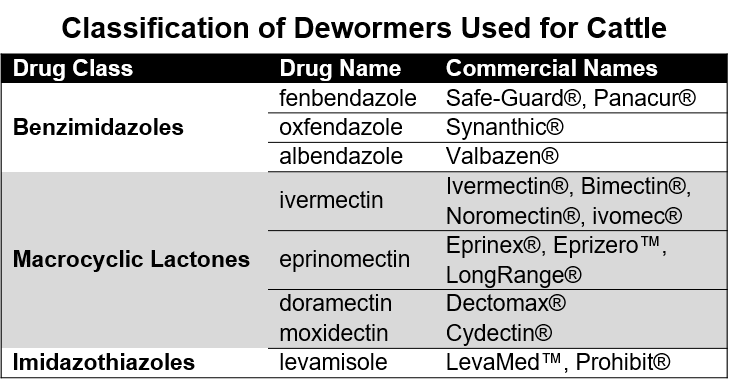Source: University of Maryland
Many producers are aware that gastrointestinal parasites can reduce cattle performance, and accordingly, take measures to protect their animals. Gastrointestinal parasites are typically controlled through application of drugs called anthelmintics (dewormers). There are three major dewormer categories available to livestock producers: benzimidazoles, macrocyclic lactones, and imidazothiazoles. Dewormers in the benzimidazole and macrocyclic lactone classes are the most widely utilized for cattle. Macrocyclic lactones are available as in pour-on or injectable forms, while benzimidazoles are typically administered orally.

Although cattle producers have the best intensions when it comes to treating their animals for intestinal parasites, routine and frequent anthelmintic treatment is likely contributing to resistance. Similar to antibiotic resistance, continued overuse of dewormers inadvertently selects for drug-resistant parasites. Dewormer resistance has been well-documented in small ruminant production systems and those producers have had to adopt strategies to cope with significantly reduced efficacy of dewormer treatment. Data from cattle herds in the southeast U.S. as well as those in other countries suggest that economically important parasites to the cattle industry are also developing resistance to available dewormers.
With the current practices of routine administration of dewormer to all animals on the farm multiple times per year, it is likely that cattle producers are 1) administering dewormer to animals that do not actually need to be dewormed; or 2) administering a product with poor efficacy in their herd. Both situations represent an economic loss to the producer and contribute to the development of dewormer resistance. In order to mitigate the development of dewormer resistance in cattle production systems, producers should take measures to evaluate and adjust their parasite control program.
Producers can determine if their current program is working by conducting a fecal egg count reduction test on a group of cattle. The premise of the fecal egg count reduction test is to determine dewormer efficacy by measuring how many parasite eggs are present in the manure before dewormer treatment and how many are present after treatment. A dewormer is considered effective if there is at least a 95% reduction. Producers who are interested in conducting a fecal egg count reduction test should contact their veterinarian or local extension agent for additional details and instruction.
If producers find that their current program in not effective according results obtained using a fecal egg count reduction test, they should consider the following practices:
- Only deworm “high risk” animals. These animals include younger cattle (<16 months), especially calves. Older cattle generally develop a tolerance to gastrointestinal parasites and are better able to cope with their presence than younger animals.
- Do not deworm by the calendar. Cattle should only be dewormed when they need it, not simply because of the season or time of year. A single composite fecal egg count can be performed for a group of cattle to evaluate current parasite load.
- Perform selective non-treatment. This practice ensures that there are sufficient parasite numbers that are unexposed to an anthelmintic which will help maintain a population of susceptible parasites (referred to as “refugia”). To implement this strategy, producers should deworm all animals in their high risk groups except for the top 10 to 15% heaviest/best performers.
- Utilize combination treatments. This strategy involves simultaneous treatment with at least two drugs in different classes (e.g., one benzimidazole and one macrocyclic lactone; levamisole and one benzimidazole, etc.). With this approach, any parasites resistant to one drug class will likely be susceptible to the other class, which would greatly reduce selection pressure for resistance to either drug. This method is much more effective in controlling the development of resistance than rotating between drug classes.
- Avoid under-dosing. Under-dosing commonly occurs when animals are not weighed prior to treatment such that a lower dose is used than is required for maximum effect. This is a serious problem that certainly contributes to the selection of resistance. To avoid under-dosing, be sure weigh animals to determine proper dosage. Ideally, a set of scales is used for this; however, if scales are unavailable, use of an appropriate weigh tape is better than nothing.
- Examine grazing practices. Short forages resulting from overstocking and overgrazing pastures forces animals to graze closer to manure piles and increases the risk of parasite exposure. Implementing rotational grazing and giving paddocks adequate rest (4-5 weeks) can also help break the parasite life cycle and reduce risk of exposure.
- Continue to evaluate the program to ensure efficacy. This can be accomplished by performing a fecal egg count reduction test every few years.
References for further reading:
Kaplan, R. M. 2020. Biology, Epidemiology, Diagnosis, and Management of Anthelmintic Resistance in Gastrointestinal Nematodes of Livestock. Vet. Clin. Food Anim. 36:17–30. https://doi.org/10.1016/j.cvfa.2019.12.001








